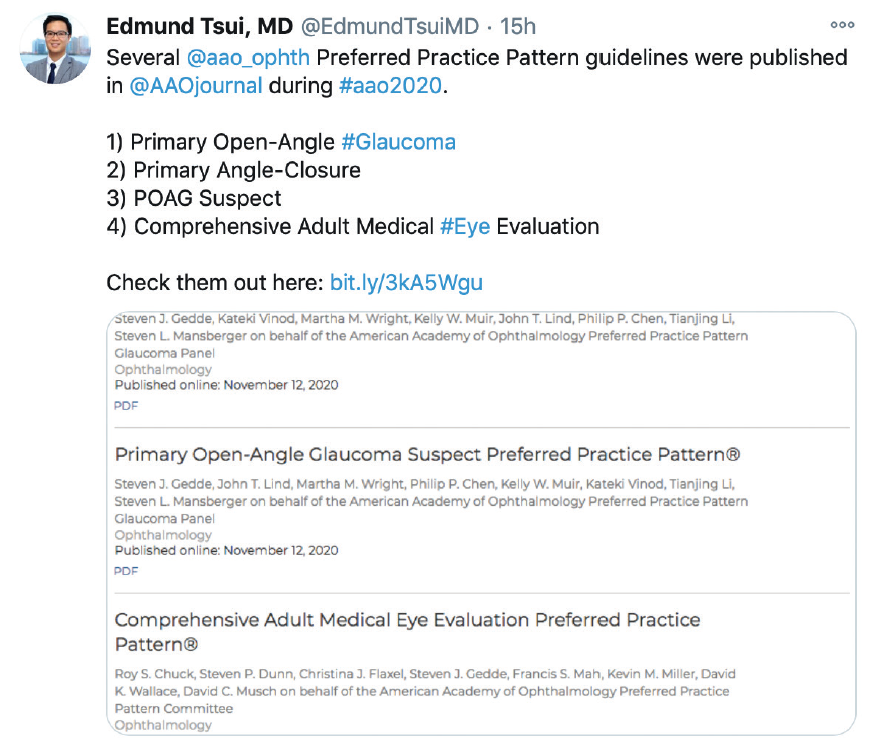
Social media has become increasingly widespread in today’s society because it provides a rapid and accessible means of exchanging information. People often use social media platforms to consume news, keep up with family and friends, and share photographs. Numerous academic and professional uses have also emerged.
New applications of social media were bound to arise as a result of a constantly expanding user base. According to current estimates, 3.6 billion people worldwide use social media.1 As of July, there were 2.6 billion monthly active users on Facebook, 1 billion monthly active users on Instagram, and 326 million monthly active users on Twitter.2
Within the field of medicine, the use of social media has been steadily increasing, with more medical professional accounts popping up on Facebook, Instagram, Twitter, LinkedIn, and TikTok. Twitter in particular has been widely adopted by physicians and trainees,3 many of whom have been especially active during the COVID-19 pandemic. This article focuses mainly on that platform.
THE FIRST STEP
For those who have yet to take the plunge into social media, choosing where and how to begin can be a daunting task. Making an account, however, requires little time or effort and is an easy place to start. When creating a professional social media account, be sure to use your real name and photograph. This allows other users to recognize and connect with you. Many platforms, including Twitter, enable users to fill out a profile or description section, which can be used to describe your background, expertise, and interests.
Once your account has been created, you can start connecting with colleagues and organizations. To start building your network, see Twitter Accounts to Follow.
TWITTER ACCOUNTS TO FOLLOW
Organizations
- AAO | @aao_ophth
- ASCRS | @ASCRStweets
- ARVO | @ARVOinfo
Journals
- Ophthalmology | @AAOjournal
- American Journal of Ophthalmology | @AJOphthalmology
- JAMA Ophthalmology | @JAMAOphth
- Investigative Ophthalmology & Visual Science | @ARVOiovs
Online Resources
- Cataract & Refractive Surgery Today | @CRSToday
- MillennialEYE | @MillennialEYE
- Glaucoma Today | @GlaucomaToday
- Retina Today | @RetinaToday
- Eyetube | @eyetubenet
TWITTER 101
Twitter is a microblogging platform that allows users to share tweets, which are short posts containing a maximum of 280 characters (in the earlier days of Twitter, the limit was 140). Ultimately, the goal of Twitter is to share updates with other users. The visibility of a tweet—or how many users will see that tweet—is therefore often considered when crafting a post. User engagement—or how many users will interact with a tweet—is also a consideration.
To maximize visibility and user engagement, Twitter users can include links to other websites and attach images to their tweets. Users can also retweet or share another user’s tweet to their own followers, reply to tweets to initiate conversations with other users, and like others’ tweets. Tagging other users in a tweet can garner additional attention and increase user engagement.
The use of hashtags (a clickable keyword preceded by the # symbol) serves as an effective filter and search mechanism to identify relevant posts. Effective tweets may include several applicable hashtags to identify topics of interest, such as #ophthalmology. One caveat: Some social media experts maintain that the most effective number of hashtags is two per tweet, so be careful not to overdo it.4
USES FOR OPHTHALMOLOGY
Twitter provides a variety of useful applications for medical professionals. Physician users can use the platform to connect with colleagues, educate physicians and patients, disseminate research, and communicate at meetings (Figure).5 The use of Twitter has been promoted at events such as the AAO, ASCRS, and ARVO annual meetings, and participants are often encouraged to tweet about talks, share their thoughts, and connect with other attendees.

Figure. An effective tweet may tag other users (eg, @aao_ophth); contain several topical hashtags, including meeting-specific hashtags (eg, #aao2020); and feature a relevant link and/or image for more information. As shown in this tweet, shortening links via Bitly can help users stay within the Twitter-mandated character limit.
Meeting-specific hashtags, such as #aao2020, help users identify content relevant to each event. Attendees can filter through the posts in their feed by clicking on the meeting hashtag. The use of a meeting hashtag also permits those outside the conference to follow the event and interact with participants in a virtual capacity. Further, many ophthalmology conferences, including the AAO, ASCRS, and ARVO annual meetings, often offer workshops and sessions dedicated to discussing social media and its use for professional activities such as practice building, marketing, and networking.
For those interested in public health and patient education, Twitter can be used to share reputable and accurate information on eye health with the public by retweeting or sharing links from the AAO (www.aao.org/eye-health/resources/articles) or the National Eye Institute (www.nei.nih.gov/learn-about-eye-health/resources-for-health-educators). These organizations also offer social media toolkits to assist users with their public education and eye health awareness efforts.
Ophthalmologists on Twitter can reach broader audiences by tweeting about their research. Short posts that summarize the research and include a link to the article can help increase the visibility of new data. Publicly sharing research on social media also enables those outside ophthalmology or medicine to learn about certain topics. The creation of online journal clubs, which can include trainees, scientists, and physicians on a global scale, can lead to wider discussions and new collaborations. Furthermore, many national and international ophthalmology organizations and journals have social media accounts that they use to share newly published studies before they appear in print. Many journals also now ask study authors for their social media handles to include in the publication.
PATIENT PRIVACY
Social media offers many benefits for physicians. It is imperative, however, that users across all platforms abide by the laws set forth by the Health Insurance Portability and Accountability Act.
Many users post clinical images or case reports to share with colleagues. Caution must be exercised, however, when sharing information online, even with patient consent. Additionally, physician users should follow the social media policies set forth by their institutions or organizations.
CONCLUSION
Social media platforms offer many creative avenues of communication for ophthalmologists looking to connect with a global audience. These tools offer opportunities for networking and collaborating on research efforts, and they enable the rapid dissemination of up-to-date information and study findings. The use of social media will only continue to increase across all platforms. For those looking to be a part of the conversation, there is no time like the present to create a Twitter account and join the community on #ophthotwitter.
1. Number of worldwide social network users. Statista. Accessed November 1, 2020. www.statista.com/statistics/278414/number-of-worldwide-social-network-users
2. Global social networks ranked by number of users. Statista. Accessed November 1, 2020. www.statista.com/statistics/272014/global-social-networks-ranked-by-number-of-users
3. Chan TM, Dzara K, Dimeo SP, et al. Social media in knowledge translation and education for physicians and trainees: a scoping review. Perspect Med Educ. 2020;9:20-30.
4. Hartshorne D. Twitter hashtags: a guide to finding and using the right ones. Sendible. March 19, 2020. Accessed November 1, 2020. www.sendible.com/insights/twitter-hashtags
5. Tsui E, Rao RC. Navigating social media in #ophthalmology. Ophthalmology. 2019;126(6):779-782.




